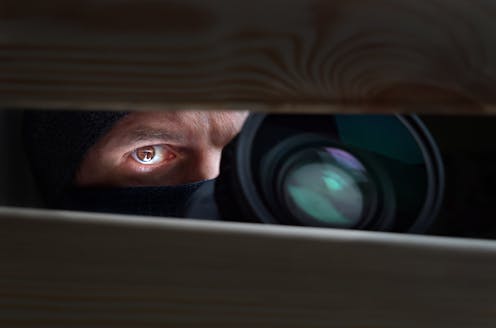Why have Australia’s espionage authors been renditioned to a literary black site?
- Written by David Rymer, PhD Candidate Investigating Australian Espionage Fiction, University of the Sunshine Coast

Internationally, spy novels are surfing a 40-year wave of commercial success that has transformed the genre into a multi-billion-dollar behemoth spanning books, television and movies.
Different styles of espionage fiction tend to reflect the characters and attitudes of different nations. Among the most famous British examples are the urbane spy novels of Ian Fleming[1] and John Le Carré[2]. By contrast, the evolution of Tom Clancy[3], from bestselling author to content creator to brand, demonstrates the very different approach to the genre taken in the United States.
Clancy’s debut novel, The Hunt For Red October[4] (1984), which introduced the character of Jack Ryan, was at the vanguard of a new wave of American espionage fiction, deftly blending traditional spy stories with gritty military fiction. It was reputedly the only book President Ronald Reagan read while in office.
Clancy transformed his fiction into a successful literary franchise. Along the way, he was criticised for his preference for monologues over dialogue, his unabashed praise of American militarism and geopolitical hegemony, and his passion for things that go “bang” and “boom”. During his life, he wrote or co-wrote 19 novels and 11 non-fiction works, complemented by a raft of video games, comic books and tie-ins. When he died in 2013, he had 100 million books in print and left an estate worth US$83 million[5].
Since his death, Clancy’s estate has commissioned a further 22 posthumous works and created a self-sustaining “Ryanverse”, comprising two further movies and four television series. Worldwide box-office takings of the five Jack Ryan movies stand at more than US$920 million[6]. In May 2024, the Ryanverse celebrated the 40th anniversary of the publication of The Hunt For Red October with the release of Tom Clancy Act of Defiance[7], written by Brian Andrews and Jeffrey Wilson – the 19th novel in the Jack Ryan series.
Where is the Australian espionage fiction?
In Australia, aspiring espionage authors appear to have been renditioned to a literary black site. Espionage fiction is the nation’s unloved genre, maligned as the unwanted love child of psychological thrillers and historical fiction.
A recently created database of espionage fiction (currently offline, as it is being updated), records 2,323 works written by 462 novelists across the English-speaking world. It includes works published from 2001 to 2024 and novels scheduled for release in 2025.
The database reveals Australia’s anaemic contribution to the genre. It includes only 78 novels by 29 Australian writers. Only 16 of Australia’s 47 publishing houses launched novels in the espionage genre from 2001 to the present. From 2003 to 2005, during the early years of Australia’s high-tempo Special Forces operations in Afghanistan, our collective publishers could only find five spy manuscripts deserving of publication. Our high water mark in 2018 saw only nine espionage novels appear in print.
By contrast, according to Australian Crime Fiction HQ[8], 97 crime novels were published in Australia in 2022 alone[9]. There were six Australian espionage novels that year, four of them self-published.
Yet Australia’s historical entanglement with espionage dates to early European cartographers’ speculation about the existence of a southern landmass. Captain James Cook, ostensibly sent by the British Admiralty to observe the transit of Venus, was under secret instructions to find and lay claim to a “land of great extent[10]” – the Great South Land, thought to exist in southern latitudes. Espionage has played a covert role in Australia’s history ever since.
The first Australian spy novel, A.G. Hales’ Little Blue Pigeon: A Story of Japan[11], was published in 1905 , 84 years after the world’s first example, James Fenimore Cooper’s The Spy[12] (1821).
A growing, if neglected, stream of local fiction has continued to bear witness to Australia’s involvement in espionage, though it has received little critical attention, despite the genre’s global popularity. Nor is there much understanding of how Australian espionage fiction draws on other genres, how the genre has evolved, and how it compares to international forms.
One of the under-explored characteristics of espionage fiction is its degree of fluidity with other genres. Analysis of the database suggests it shares its DNA with other popular genres, crossing over with crime fiction, action-adventure thrillers, historical fiction, romance and military fiction. There is even a “spy-fi[13]” sub-genre that incorporates science-fiction elements.
Literary agents-of-influence
Does it matter whether Australia publishes one, two, four or 20 espionage novels a year? Or none?
Yes, it does. Stories help us understand our culture and our history. The allure of espionage fiction is its insights into complex areas of human motivation, behaviour and thought processes. Quite how these motivations, behaviours and ways of thinking have influenced Australia’s collective social sense-making remains elusive.
There is commercial potential here too. Australia’s creative industries sector contributes more than A$90 billion to the national economy, exports $3.2 billion annually and employs more than 600,000 Australians[16]. Locally produced genre fiction does well overseas – the rise of outback noir and Tasmanian gothic are notable examples.
Matthew Reilly[17]’s thrillers, some of which are clearly influenced by Clancy, continue to deliver solid sales, even as he bends genre conventions. John Birmingham[18]’s edgy alternative history novels, which adapt Clancy’s militarism in a more playful spirit, have also carved out a place commercially.
One sub-genre of espionage fiction proving successful for Australian writers is historical fiction. Kelly Rimmer[19] and Rebecca Starford[20] have set novels against a backdrop of espionage in war-torn Europe, while Julia Levinta[21]’s debut The Girl from Moscow tells a story of Cold War intrigue. Nicholas Jose, an established literary author, recently published The Idealist[22], an espionage novel that examines Australia’s murky dealings around the time of East Timorese independence in 1999.

















